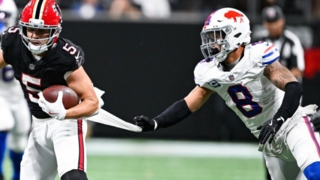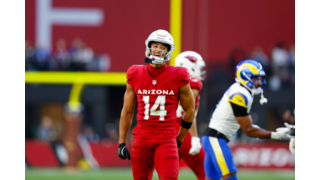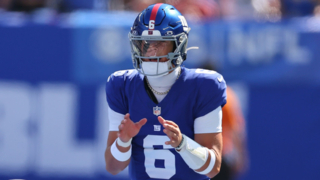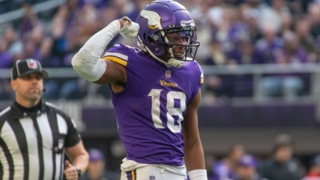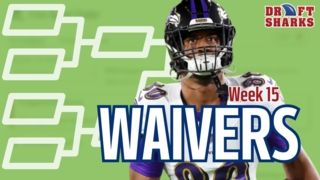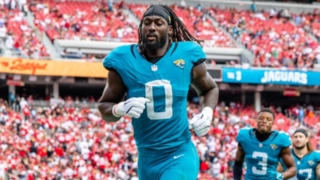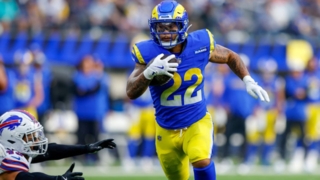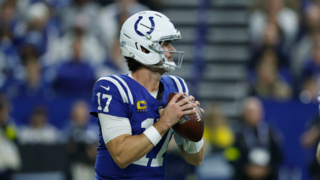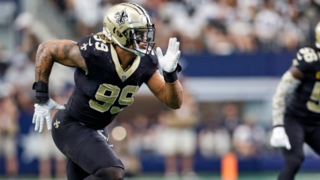2015 Auction Strategy Guide

If you love the strategy that goes into playing fantasy, then you really need to do some fantasy football auction drafts.
Sure, you put some planning and strategy into your snake-drafted squad, but much of what you do will fall under the control of others because you can only choose from among the players available when your turn comes up.
But an auction format means that every owner gets a shot at any player he or she wants. In case you're not familiar with auctions, here's a quick primer:
-- League owners take turns nominating players for auction (also called "posting").
-- Each team/owner starts with a finite bank to use for bidding (most commonly $200).
-- Owners bid auction style until nobody wants to beat the current bid.
-- High bid gets the player.
-- Repeat until all rosters are full.
Everyone needs to fill the same number of positions with the same number of dollars, but there are many ways to do so -- and even many methods that can produce winning teams. That's why we've put together this guide to take you through your draft and down the road toward a championship.
Before you start drafting, set up an MVP Board just as you would for any other draft. In addition to the usual columns for projected points, MVP+ values and other material, the board will provide auction values for every player, tailored to your lineup and scoring settings.
The difference with an auction board, though, is that you need to enter the approximate number of players you plan to draft at each position -- not your actual starting-lineup settings. For a 2RB-3WR setup, we tend to go with 2 QBs, 4 RBs, 5 WRs, 2 TEs, 1 Flex, 1 K, 1 D/ST (plus however many bench spots beyond that you use).
That might not be your exact roster breakdown or even your desired breakdown. But it'll give you a good dollar-value guide heading into your draft.
Also note that the dollar values should just serve as a guide, not a hard ceiling. Try to decide ahead of time which players/positions you're willing to spend a little more for and where you want to try to save money.
Now, on to the more specific strategy ...
Nominating Strategy
Start with kickers and defenses
Posting these positions at the top of the draft can accomplish 2 things:
1) You can lock down a $1 starter at each spot, which will be the way to go in many leagues. If you're league scoring makes Ds a bit more important and you want to go to $2 or $3, you still get to control the action by going for it early.
2) If you're not going past $1 at either spot, you can force league mates to throw some extra dollars at more-popular options. They won't think it's a big deal to spend an extra dollar or 2 early, but every buck matters -- especially in the later stages.
Then post high-dollar players you don't want
Every roster-worthy player has a price, but you'll inevitably go into the draft with some guys you don't like nearly as much as others do. If you know you're not willing to blow a quarter of your budget on 1 RB, post him early so that others will.
This strategy works beyond the expensive studs, too. If you know you're not paying Sammy Watkins' likely price, for example, post him early enough that someone's likely to drop $25 on the Bills' #1 WR.
Throw out some mid- to high-level players you'd take only at value
Perhaps you'd be fine with Amari Cooper at a certain price but wouldn't mind seeing someone else buy him. Toss out the Raiders rookie earlier in your draft to try to get someone to overpay. And if the your league mates shy away, you can get him for a nice price. Just don't try this with players you don't want on your roster. And try to avoid bidding up a player you don't want just to get a league mate to pay more. That's a good way to get stuck with a player and bust your plan.
Consider posting others' handcuffs
DeAngelo Williams is gonna be worth more to the Le'Veon Bell owner than he will to you. Throw Williams out there earlier in your draft to make the Bell owner pony up $6 or so instead of the $2 or $3 he might be able to get away with late. Then that person will have less money to play with when you're sifting through the late values still lingering on the board.
Go get any of your remaining guys
Waiting as long as you can before posting any favorites will allow for many others to burn through their budgets. And if someone else nominates them first, you can always bid on them.
Bidding Strategy
Figure out your starter and bench budgets
This will obviously depend on your particular roster size, and perhaps on format. In a Draftmasters setup, for example, it makes less sense to blow a bunch of money on your starting lineup at the expense of your bench.
For lineup-setting leagues, plan to spend about 80% on the starters and 20% on the reserves. That breakdown can work at least as far down as a 20-man roster. If you figure a 10-player starting lineup (including a flex), that would leave $40 to fill out the bench. Averaging $4 per reserve might seem low, but you can budget in a few $1 players. We like to plan on 3-4, which would increase your reserve average to the $5-$6 range.
You'll likely be able to find quality reserves at TE and QB for less than $5, and all player prices will come down later in the draft as owners start to run out of money.
And, of course, your budget can adjust as needed during the draft if you get starters for less than expected or decide to go a few dollars higher to land a certain player or 2. But go in with a plan here to make sure that you don't screw yourself during the draft.
Set your (relative) ceilings ahead of time
As mentioned earlier, you shouldn't treat the dollar values on your MVP Board as hard caps. You probably could and still come out with a fine team, but is it worth missing out on Frank Gore because his price tag travels $2 north of what your board says? We'd say no. But that's up to you to decide before draft time -- before the emotion of chasing after "my" guy takes over.
Be patient, but not hesitant
Unless you have whittled down your players-of-interest list to an extremely finite group, you simply can't buy everyone you want.
If you've decided that you don't want to buy 1 of those top 6 players that will likely cost $45 or more, then stick to it. If you don't want to spend more than 40% of your starting budget at WR, then you shouldn't pay $20 for a WR3 type. If you've budgeted $15 for your starting QB, then passing that cap will take away from the money available at other positions. You might be willing to do that, but you'll need to decide where else to adjust to make up for it.
Owners will likely be excited to start getting players to build their roster early, but it's easier for everyone to spend money when everyone has it. Don't chase the market early and overpay. But you also shouldn't completely sit out early bidding just because you're hoping to save your money for later.
Mind your budget and your roster
This repeats a bit from the last section, but it's important. You can't go past your relative cap without affecting the rest of your spending. So make sure you take into account how much money you'd like to have left, how many starting spots you still need to fill and how many roster spots remain. It'll be painful to sit there at the end of the draft watching others buy low on players you like because you only have $1 left per roster opening.
Team Building
I mentioned up top that there's no one way to build a team, so let's go through multiple scenarios by position here. Of course, mining lower-priced value players will be key to any scenario, and you can look to our various sleeper lists and suggestions for candidates. You should also check out our Average Auction Values article for some potential value targets.
QB
Just like in standard drafting, waiting makes sense here. "Waiting" is a little different in an auction, because you can pounce on value if it comes earlier in the draft and still adhere to the same approach. But here's the basis: Overspending at QB probably won't help you.
If you absolutely must have Andrew Luck or Aaron Rodgers on your team, then it's certainly possible to make it work. But you'll probably have to spend anywhere from $30 to $40 to land him. Do you really want to spend 20% of your overall budget on 1 guy at a position where Smola's 2014 streaming picks would have produced the position's 8th-best full-season fantasy total?
Peyton Manning looks like the 1st potential value, but don't consider him for anything more than $20. And if you do buy him at that price, don't spend more than $5 -- and preferably less -- on a backup. The only reason you pay up like that at QB is to get a guy who can start pretty much every week. You'll notice in our Average Auction Values article that even Manning checks in at less than half the price on the MVP Board of what he draws across big sites.
Your best bet at QB is to wait until 10 or so are off the board and then target someone in the range of Ryan Tannehill down to Tom Brady (according to your MVP Board rankings). You should be able to get someone from that group for $10 or less. Throw in Sam Bradford, Philip Rivers, Teddy Bridgewater and Carson Palmer, and you should be able to snatch a pair of QBs with top-12 fantasy potential for less than $20 total.
Likely even cheaper options such as Alex Smith, Andy Dalton, Jay Cutler, Blake Bortles and Marcus Mariota can serve as fall backs. There are a ton of usable QBs. That's the key thing to keep in mind.
RB
Spread it around
You have to spend your money somewhere. If you save it at QB, then you'll have more to pay for RBs, WRs and/or TEs. We'll get to the stud runners in a few paragraphs, but let's start with perhaps the most attractive RB approach for your auction.
The top RBs in your league will probably cost about 25% of your total budget -- around $50 in a typical $200 auction format -- maybe more. Our AAV chart actually showed 8 RBs priced at more than $50.
Those guys make for decent investments in a snake draft, because you have a pretty good idea of what WRs and other RBs you can expect to find over the next 3-4 rounds. But if you drop $45-$50 on a single player in your auction, then you're limiting your spending power elsewhere.
Wanna start with a stud RB and a stud WR? Then plan on paying anywhere from $85-$100, depending on which guys you're targeting and how highly the rest of your league values them. And your league will especially value the runners.
According to our AAV chart, the top 8 overall players in average value -- at least as of late July -- were all RBs. That's combining numbers from CBS, ESPN and NFL.com. If you set up your MVP Board as laid out above, you'll likely find 4 WRs listed before the 1st RB -- whether you play with PPR or not.
We'll get to the receivers in a bit, but the takeaway here is that you're going to have to pay up -- way up -- for a "stud" RB. So decide just how important that guy is to you.
On the other hand, you could take the money you might spend on Jamaal Charles and land 2 potential top-15 RBs. The players you can expect to go for more like $30 or less include (in no particular):
Lamar Miller
Alfred Morris
Justin Forsett
Frank Gore
Ameer Abdullah
Jonathan Stewart
Andre Ellington
Latavius Murray
C.J. Spiller (especially after his knee scope)
T.J. Yeldon
Doug Martin
Skip over the stud runners and you might comfortably land 3 RBs from this group. By ESPN auction values, for example, you could expect to get Forsett ($24), Gore ($18) and Stewart ($20) for just about $7 more than Eddie Lacy alone would cost.
The specific numbers and specific players will vary quite a bit by league, but you get the point. You can avoid the high bust rate that has pushed more RBs out of Round 1 in recent seasons and still land high-upside backs.
Need a stud?
As we mentioned earlier, you can certainly win with a stud RB on your auction team. The key -- beyond, obviously, happening to draft the right players -- will be targeting values. If you like a few players among the top group, then set a cap for your spending. If you can land an RB1 for $35, great. If you can't, know that you can fall back on the RB group above.
Patience pays off here as well. All player prices will dip later in an auction, because there's less money to spend. So figure out where your top tier (or tiers) ends and know what you're willing to wait for. LeSean McCoy could turn into a value given his recent hamstring injury, though that obviously adds risk as well.
The RBs carrying Round 2 ADPs right now will likely deliver more value in your auction than those at the top of Round 1. We don't project a huge gap in production between those RB groups.
Handcuffs
Don't overpay. You'll need to figure out if paying more than $5 for a player you'll likely only use if a starter gets hurt makes sense on your roster. It might take that much or more to secure high-upside handcuffs such as Knile Davis and DeAngelo Williams. If someone else is determined to bid you up, though, let the other owner take that RB and spend your money elsewhere.
Snatching a handcuff becomes more valuable the more you pay for a top-end RB, because spending big money on that RB1 will leave you less to spread around the rest of the position. Try to factor Davis, Williams, Jerick McKinnon or James Starks into your auction plan if you're targeting 1 of our top 4 RBs.
WR
Safer, cheaper studs
As we mentioned above, you'll likely find 4 WRs listed as better auction values on your MVP Board than the 1st RB. That's primarily because:
1. You'll probably start more wideouts than backs.
2. There's a gap after our top 7.
That top tier is more pronounced in PPR, where 15 points separate #7 Odell Beckham from #8 Randall Cobb. These top 7 guys merit prices right up there with the top RBs, but they probably won't go as high in your draft. If you want to anchor your auction team with at least 1 stud, this is a group to target -- especially because our #1 guy, Demaryius Thomas, is nowhere near a consensus #1. Antonio Brown will almost always cost more at auction, with Julio Jones, Dez Bryant, Beckham and perhaps Calvin Johnson and Jordy Nelson in the same range.
Thomas at $40-$45 looks better than Le'Veon Bell at $50-$55.
The values beyond
The prices of the rest of the receivers will vary wildly depending on how your draft goes. Use your MVP Board to discern the tiers at the position -- and other positions -- and use that to determine value targets throughout your draft.
Of course, that doesn't necessarily mean you should go after a guy just because his price tag is lingering below what your Board lists as his value. You can't buy everyone you like, so don't leave yourself out of the running for a favorite by spending on a "meh" option.
Judging by AAV, here are some guys who could stand out as big values:
Keenan Allen
Golden Tate
Jeremy Maclin
Andre Johnson
Jarvis Landry
Allen Robinson
Charles Johnson
TE
Gronk
Everybody's favorite TE could also make for a nice target if you want a stud at a fairer price. In terms of the value that he'll bring to your stating lineup, Rob Gronkowski rates right up there with the top RBs and WRs. (He'll sit lower on your MVP Board because the settings follow the roster alignment rather than that of the starting lineup.)
But Gronk's AAV came in lower than the top 9 RBs and Antonio Brown. Beyond that, you'll probably find far fewer owners willing to pay $40 for a TE than for a RB1 -- or even a WR1. So you just might be looking at Gronk in the $30-$35 range as opposed to $45+ for studs of similar value.
If that's the case, he's a fine pickup. At the same time, buying him at auction comes at a greater cost to the rest of your roster than drafting him in a snake format does -- just like with the top RBs. If you pass on Gronkowski, you can likely land a solid starting TE for $10 or less. AAV found just 3 TEs with double-digit price tags.
The next guy
Jimmy Graham should check in well behind Gronk in auction price, but probably not far enough for us to like him. He still figures to push or exceed $20, and that's just too big an investment. So Travis Kelce and Greg Olsen look like the next reasonable level.
An MVP Board set to PPR with the position settings at the top of this article finds Graham at two-thirds of Gronk's value ($14 vs. $21). Then come Kelce and Greg Olsen tied at just $1 less.
Kelce's the upside play here, with a still-developing game and athleticism that gives him a higher TD ceiling than Olsen. The Panthers TE got a slight bump in value this week from Kelvin Benjamin's ACL tear. That could drive even more targets toward Olsen, who already led all NFL TEs in percentage of team targets last year. Paying anywhere from $12 to about $15 for Olsen or Kelce looks solid.
Waiting on a TE
If you opt out of the double-digit priced TEs, you'll still find plenty of options. Just keep an eye on the TE list on your MVP Board for the remaining values as players get picked. Anyone down through Kyle Rudolph at 14 (depending on your setup) could make for a decent #1 TE. If you skimp on that 1st guy, go ahead and snatch a 2nd from the bargain group.
K and D/ST
Just don't pay up for them. Any of them. Get what you can for $1 apiece -- even if it's a pair of $1 defenses instead of 1 for $2. The only time it makes sense to pay more is later in the draft if you still have money to burn.
Draft using the best dynamic tool in the industry. Our fantasy player valuations (3D Values) change during your draft in response to...
- Exact league settings - direct sync
- Opponent and Team Needs
- Positional scarcity & available players
- Ceiling, injury risk, ADP, and more!
You need a dynamic cheat sheet that easily live-syncs with your draft board and adapts throughout your draft using 17 crucial indicators.
Get your Draft War Room Today
 Redraft
Redraft Dynasty
Dynasty Best Ball
Best Ball